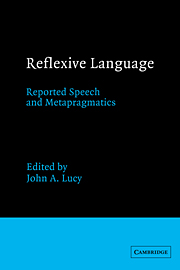Book contents
- Frontmatter
- Contents
- Acknowledgments
- General introduction
- Part I Theoretical foundations
- Part II The relation of form and function in reflexive language
- Introduction to Part II
- 3 The boundaries of reported speech in narrative discourse: some developmental aspects
- 4 Metapragmatic presentationals: reporting speech with quotatives in Yucatec Maya
- 5 Metalanguage and pragmatics of deixis
- 6 Learning what to ask: metapragmatic factors and methodological reification
- Part III Text, context, and the cultural functions of reflexive language
- Part IV Interpretation, reported speech, and metapragmatics in the Western tradition
- Name index
- Subject index
5 - Metalanguage and pragmatics of deixis
from Part II - The relation of form and function in reflexive language
Published online by Cambridge University Press: 22 January 2010
- Frontmatter
- Contents
- Acknowledgments
- General introduction
- Part I Theoretical foundations
- Part II The relation of form and function in reflexive language
- Introduction to Part II
- 3 The boundaries of reported speech in narrative discourse: some developmental aspects
- 4 Metapragmatic presentationals: reporting speech with quotatives in Yucatec Maya
- 5 Metalanguage and pragmatics of deixis
- 6 Learning what to ask: metapragmatic factors and methodological reification
- Part III Text, context, and the cultural functions of reflexive language
- Part IV Interpretation, reported speech, and metapragmatics in the Western tradition
- Name index
- Subject index
Summary
Introduction
In performing an act of demonstrative reference, as in “that's it” (said pointing), a speaker produces a special kind of relation between himself or herself, an addressee, and the object of the point. One of the main ways in which natural language deictics differ from one another is in the kinds of relations they establish between participants and referential objects, familiar examples being Proximal to Speaker, Visible to Speaker and Addressee, Distal to Speaker, and so forth. Languages clearly differ in the kinds of relational features they encode (Anderson and Keenan 1985, Fillmore 1982, Hanks 1987, 1989), and the determination of these features is a central part of the empirical study of deixis. Beyond the identification of referents however, demonstrative usage mobilizes a number of other relatively well-known functions too. These include ostensive presentations of a referent (Hanks 1984b), predication of identity or location (“There it is,” “That's it”), direction of an addressee's attention (“There! [look!]”), along with other extra-referential effects (Levinson 1983: 89ff; Silverstein 1976). In many, though not all, cases of demonstrative reference, a crucial role is also played by the execution of bodily gestures simultaneous with the utterance, such as pointing, directed gaze, handing the object over, cocking the head or pursing the lips (Sherzer 1973).
Information
- Type
- Chapter
- Information
- Reflexive LanguageReported Speech and Metapragmatics, pp. 127 - 158Publisher: Cambridge University PressPrint publication year: 1993
Accessibility standard: Unknown
Why this information is here
This section outlines the accessibility features of this content - including support for screen readers, full keyboard navigation and high-contrast display options. This may not be relevant for you.Accessibility Information
- 27
- Cited by
